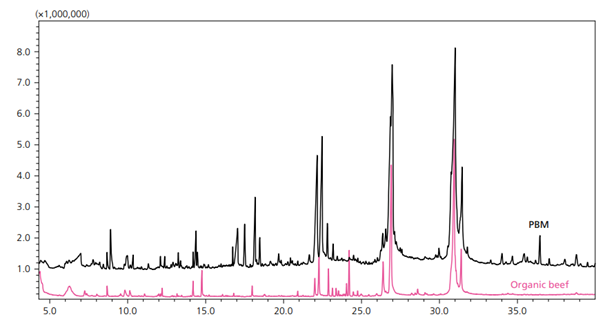
Panel discussion on...
Healthy lifestyle
Welcome in the world of alternative meat: analytical challenges and perspectives

Introduction
1) Societal demands to healthy lifestyle as medicine has changed dramatically in the last 12 months. We are all getting older, but enjoying a long and healthy life is not a given. Our quality of life is declining. Although our lifespan continues to increase, our healthy years – or health span - have declined. At the same time the medical care is under enormous pressure due to shortage of personnel. Healthy lifestyle could serve as a medicine to relief this societal pressure, by 1) maintaining health in persons that are healthy; 2) prevention of or delaying the onset of a chronic lifestyle related disease and 3) curing or remitting persons with a lifestyle related disease. Although consumers are more aware of the impact of healthy lifestyle, consumers however do not know on how to make this actionable to them. In The Netherlands, the public momentum for lifestyle approaches to fight disease burden is increasing.
2) The greatest scientific achievement in nutritional sciences in the context of healthy lifestyle is in the personalisation of nutrition. Persons have a personal nutritional requirement that depends on their metabolic phenotype. The implementation of continuous metabolic measurements into nutritional sciences, such as continuous glucose monitoring, shows this individual response to nutritional interventions, but also provides direct feedback to consumers on the impact of their lifestyle behaviour on metabolism, helping with consumer awareness and behaviour change.
3) Because of technological developments that are being implemented in nutritional sciences in recent years such as gut microbiome measurements as well as the use of continuous glucose measurements and other digital wearables many of the clinical studies focus on health benefit areas related to gut health and or glucose metabolism. In our opinion it is important to consider health as a system and integrate the human metabolic network with the network of chronic diseases that are often interconnected as well as with the social network. Especially the integration of personal drivers, needs, preferences and the use of continuously monitoring devices that lead to a sustained nutritional behaviour change is important for future clinical studies.
4) The influence of marketing remains strong, which from a scientific view point is disputable when consumer-oriented messages are not evidence-based. Especially in the supplements category, the noise is loud, since proper regulation and maintenance is still not in place. On social media channels, the impact of influencers on the buying behaviour of especially the younger people cannot be overestimated. In the supplements and cosmetics category more regulation is needed in the interest of consumer protection. A minimal level of clinically obtained scientific evidence should be the basis for any claimed health benefit.
5) Consumers judge their health especially based on concrete symptoms or complaints. So either on physical symptoms or on health checks as part of a visit to their GP. Increasingly, wearables that provide feedback on several health aspects also provide a certain 'judgement' or 'score'. At present, consumers can judge their health status in domains as emotional wellbeing, sleep and heart rate variability. Consumer behaviour such as fitness levels and/or nutritional behaviour are not easy to assess and could offer a solution when a health issue is present in a consumer, but is not used as a way to judge on health.
Please put the following parameter in order. 1 highest priority 7 lowest priority:
1. Physical Symptoms, like pain, fatigue, constipation, weight gain
2. Medical Check-ups: blood pressure checks, cholesterol screenings, blood sugar tests
3. Mental and Emotional Well-being: stress levels, emotional balance, happiness
4. Quality of sleep: Sleep quality and duration
5. Health Tracking Devices and heart rate, sleep patterns, steps taken
6. Fitness Levels: endurance, strength, flexibility,
7. Diet and Nutrition: intake of fruits, vegetables, whole grains, proteins.
6) At TNO, we observe in consumer studies that products that are more tangible, easy and appealing receive greater consumer appreciation. Fresh foods is preferred over supplement pills. Bars and smoothies are preferred over supplement pills, but fresh foods is preferred over bars and smoothies. A meal already prepared is easier to implement than an ‘advice’ or a ‘recipe’. If the advice is aligned with personal goals it is easier for consumers to implement that when it is not the case. Direct feedback on what is the effect of the food/nutrition/supplement on their health (either on symptom relieve or through wearable output) helps consumers to implement the product in daily live.
7) In general, consumers are concerned about their weight gain although in certain social environments around the globe excess weight is perceived as an expression of being wealthy. In certain, mostly western, areas, meat consumption is under debate, as is the use of pesticides in primary production. The latter two are gaining increased momentum due to the increased public attention for Sustainable Development Goals.
8a) Lifestyle apps could help to promote certain supplements. In our view these lifestyle apps should be agnostic to supplement brands and should be evidence based (i.e. what delivery format, what personal dose of the bioactive is required). If the lifestyle app also includes direct feedback on the health effect it could differentiate between the efficacy of certain supplement brands.
8b) Yes, for some consumers this may help. It is however important to include personal requirements in the digital solutions, such as goal-setting etc. Consumers only act when there is a specific need. Not all consumers do have the health literacy to work with lifestyle apps. Blended solutions and the implementation of direct face-to-face interaction with consumers is also important, especially when working with lifestyle apps or digital lifestyle solutions in a health care setting.
8b) We as a research organisation have done multiple clinical studies with agnostic evidence-based lifestyle apps, wearables and blended care solutions to evaluate if this is effective in healthy lifestyle behaviour change in a real-world setting. It did help to achieve additional health effects and it was appreciated both by consumers as well as by health care professionals that worked with such solutions.
8c) At TNO, being a research organisation, we have developed Personalised Health knowledge and technology prototypes with and for companies, knowledge institutes and health care professionals and advise on how to use and convert these scientific knowledge and tools into concrete products and services. These include personalised nutritional advice, behaviour change technology to encourage healthy choices and testing the efficacy of developed personalised products and/or services on health (1) .
9) Artificial intelligence can help in several aspects in the development or offering (including information and education) of a personalised health service and/or product. In our view it is important that such a service or product is evidence based. TNO’s basis is an advanced modular advice system, which is a substantiated knowledge base that contains various decision trees, algorithms, data science models and artificial intelligence that can be flexibly integrated with a plug and play principle for specific user purposes. Especially also with large language models (such as ChatGPT), we believe that the translation of the advice from a lifestyle app, or just-in-time adaptive nutritional advice with the right tone of voice could be of great value. Such a personalised health product that includes aspects of artificial intelligence could subsequently be tested in a real world clinical trial and compared to the same type of product without aspects of artificial intelligence to test its efficacy.
10) As indicated above (7), the growing momentum and awareness of the importance of complying to Sustainable Development Goals (SDG) is increasingly driving industrial and consumer behaviour. In Europe, upcoming Green Deal legislation will further strengthen this development, while investors increasingly will judge industrial ambitions in this respect.
What is required to scale-up production of alternative protein sources, such as lab-grown meat and cultivated (breast/bovine) milk?
For the production of 1 kg meat approx. 1 thousand times more water is needed than for 1 kg grain. And furthermore 60% of grain production in Germany is used for feeding cattle and pork.
The development of automated production equipment for tailor-made cultured meat using 3D bioprinting will help to feed the world (4).
The 3D bioprinting technology was developed by Professor Matsusaki of the Osaka University to create muscle tissue structures. This technology is expected to be utilized in the field of food, for production of cultured meat with controlled arrangement of muscle, fat, and blood vessels.
Most of the cultured meats reported so far have a minced structure consisting only of muscle cells, making it difficult to reproduce complex structures. To solve this problem, Matsusaki and co-workers developed a 3D bioprinting technology that uses 3D printing to produce different fibrous tissues (muscle, fat, and blood vessels) and integrates them into a bundle. This technology has made it possible not only to reproduce the famous Wagyu beef, but also to delicately adjust the fat and muscle components. Osaka University and Shimadzu will jointly develop equipment to automate the production of cultured meat using this technology. (5).
What are the most effective methods for enhancing the flavor and texture of alternative proteins?There are meaningful reasons not to go for these new types of foods
Bad experience in terms of taste and texture
Raw meat on its own has little aroma; therefore, almost all aromas associated with “meatiness” are created during the cooking process by the Maillard Reaction between amino acids and reducing sugars. That reaction determines which non-volatile precursors release volatile aroma compounds. Plant-based meat (PBM), products created to resemble animal meat in both look and taste, are growing in popularity. A plant protein such as soy protein concentrate, along with colors, stabilizers, and oils, is used to successfully mimic meat flavor and texture. And, just like in animal meat, the amino acids of that protein undergo the Maillard Reaction.
Samples of PBM were run with the solid phase microextraction GC-MS and the volatile profile was compared against that of the organic beef. Similar compounds, such as fatty acids and Maillard browning reaction products, were found in both types of meat (Figure 1).
The differences can be explained by the different and wide variety of precursors present in PBM since it contains amino acids and sugars from various sources as opposed to regular meat.
There are five basic tastes, including deliciousness, which are perceived by people. The amount and kind of amino acids contribute to taste components. Of all the amino acids, glutamic acid is widely known as a component of the delicious taste. Further, the types and component ratios of amino acids largely control the flavor of food products. For example, glycine and alanine are associated with sweetness, valine and leucine with bitterness, and aspartic acid and glutamic acid with deliciousness.
The texture of food, including the sense of crispness, springiness, firmness, and the feeling on the tongue, is an important element that together with taste has an impact on the deliciousness of food. Food texture is normally evaluated using sensory tests. However, sensory tests are often difficult to reproduce, due to individual differences in people’s sensations and physical condition.
A texture analyzer can support sensory test with objective results in the form of numerical values for use in the field of food development. The texture analyzer evaluates the texture characteristics and allows a comparison of the texture of plant-based meat (PBM) and, for instance, chicken meatballs. Compared to chicken-derived products, plant-based meatballs had a higher force under loading conditions with less elasticity, which is the property to restore deformation (6). It is consistent with the result of the sensory test.

Figure 1. Overlaid Representative Chromatograms for PBM (black) and Organic Beef (pink) (6).
Panelists
Questions
1.
2.
3.
4.
5.
How have consumer awareness & demands related to healthy lifestyle changed in the last 12 months?
Where do you see the greatest scientific achievement in nutritional sciences in the last 12 months?
Are there specific health benefit areas in which significant more clinical studies are being done than in others, comparing the last 3 years?
What are the key influencers driving consumer purchasing decision for supplements or health foods? Is substantiation of claims important?
How do consumer today judge their health status?
Please put the following parameter in order 1 highest priority 7 lowest priority:
- Physical Symptoms, like pain, fatigue, constipation, weight gain
- Fitness Levels: endurance, strength, flexibility,
- Health Tracking Devices and heart rate, sleep patterns, steps taken
- Diet and Nutrition: intake of fruits, vegetables, whole grains, proteins.
- Mental and Emotional Well-being: stress levels, emotional balance, happiness
- Quality of sleep: Sleep quality and duration
- Medical Check-ups: blood pressure checks, cholesterol screenings, blood sugar tests
6.
Delivery formats can support consumer compliance and underline the technology driven approach of the brand.
a.
b.
c.
Do you see a consumer trend in preferences for certain delivery formats?
Are delivery format preference a regional, cultural aspect like taste?
Do you see a trend to carry out ingredient clinical trials using a selected delivery format as study product formulation or are most clinical studies still done in capsules?
7.
Consumer health concerns can vary widely across different regions and demographics globally. However, several common health concerns tend to be prevalent across various countries and populations due to globalization, lifestyle changes, environmental factors, and access to information.
a.
b.
Which are the key global consumer health concerns?
Do you see regional differences?
8.
There is a significant increase in the availability of apps and digital platforms focused on healthy lifestyle, particularly to support personalized approaches to mental wellbeing, metabolic support, weight management and physical fitness.
a.
b.
c.
d.
Do you see lifestyle apps as competition for supplement brands?
Do you think that these apps help to educate consumers, being more targeted when searching for supplements?
Did you consider setting up a lifestyle app to promote your supplement or your ingredient?
Did you set up a lifestyle app to promote your supplement/ ingredient and can you explore about your experience and business impact?
9.
AI (Artificial Intelligence) algorithms are today offered for various aspects of clinical trials to proof efficacy of your health ingredient or supplement.
a.
b.
c.
d.
Are consumers looking for substantiation of claims through AI driven clinical trials?
Did you consider working with an CRO specialist in AI to investigate your health ingredient or supplement?
If you applied already AI methods during the discovers/ development of your health ingredient, please share your experience and recommendation with us.
Do you think that in 2030 AI will be a manifest tool for clinical trials?
10.
A healthy lifestyle may also involve a commitment to sustainable practices for both personal and planetary health. This could include supporting ethical and environmentally conscious products.
a.
b.
c.
d.
e.
Do you agree that sustainability has become a growing concern also in the nutraceutical industry?
Are consumer looking proactively for brands which have ethical and environmental principles?
Are you looking for ethically sourced raw materials, ingredients?
Did you implement measures to establish resource-efficient processes?
Are you developing socially useful products and how do you define it?
11.
What are the major geographical differences related to healthy lifestyle trends?
a.
b.
c.
d.
e.
What are the latest trends related to claims and product forms in China?
In the U.S.
In Mexico
How are claims and dosage forms differentiated in Europe? How does your company ensure compliance with health and safety regulations in Europe?
Do you have a country where you would like to speak about trends for products?
12.
Focus clinical studies. Overall, there has been a recognized push for more gender-inclusive, geographical, and target group focused clinical research. The same trend can be seen in clinical trials for supplements or functional foods.
a.
b.
c.
d.
Please select an area you are active in and let us know which is your hot topic ingredients for 2024 for this area, based on substantiated claim, parameters, biomarkers being studied and/ or clinical study being done. Please name ingredients by scientific name and composition and not by brand name.
Please select your geographical area:
Western (EU, USA)
Asia (China, Japan, Asia Pacific)
Americas (Middle and Latin America)
Kids development/ early life nutrition/infant in Western countries and AP
Adult nutrition and prevention of developing disease
Elderly nutrition and how to support quality of life during aging
Sports nutrition, within different life decades and activity levels
References and notes























